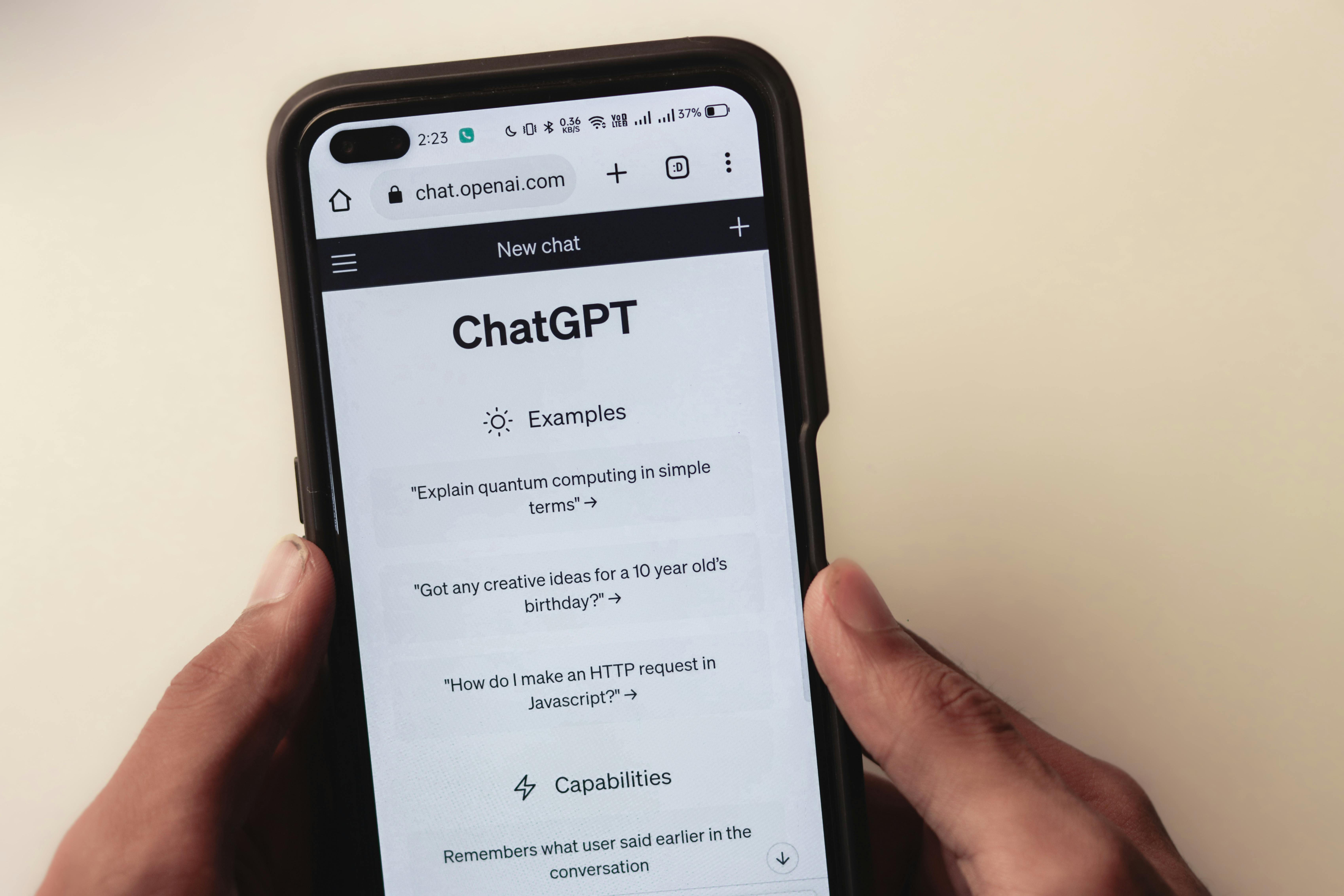Remember back in the day, when you had to manually type out every single product description, hoping you hit all the right keywords and made it sound appealing? Or when you spent hours scrolling through supplier directories only to find generic stuff everyone else was already selling? Yeah, those were the days. Days filled with busy work rather than smart work. Well, buckle up, because the game has changed, and it’s all thanks to something called Artificial Intelligence, or AI.
Specifically, we're talking about tools like ChatGPT. It's not just some fancy tech buzzword; it's a real, tangible tool that's reshaping how we do business online, especially for us e-commerce hustlers. Think of it less like a robot taking over your job and more like having a super-smart, tireless assistant who helps you make more money. Personally, I was a bit skeptical at first, another shiny new object claiming to be the next big thing. But after diving in, I can tell you, the hype is real. This isn't just about saving time; it's about making smarter decisions and ultimately, boosting your bottom line.
Crafting Listings That Practically Sell Themselves
Let's be honest, writing product descriptions can be a real slog. You need to be informative, persuasive, and somehow jam-pack all those juicy keywords in there without sounding like a robot. It’s an art form, and frankly, some days, my inner artist just wants to nap. That's where ChatGPT waltzes in like a superhero.
I remember this one time, I had a new line of handmade jewelry I was trying to list. Each piece was unique, and I wanted to capture that vibe in the description. My usual process involved staring at a blank screen for a solid 20 minutes, then forcing out a few lackluster sentences. This time, I thought, "Why not try ChatGPT?" I fed it some basic info: "handmade silver necklace, moonstone pendant, unique, spiritual connection, gift for women." Within seconds, it spat out a few options. One of them actually started with, "Embrace celestial elegance..." and went on to describe the moonstone's luminescence and the necklace's ability to connect the wearer to inner peace. My jaw actually dropped. It was better than anything I could've come up with on my own, and in a fraction of the time.
According to SellerApp, ChatGPT is a pro at helping you craft "engaging and SEO-optimized product titles, descriptions, and bullet points." You just give it a prompt, like a few key features or keywords, and boom – it generates unique content that’s tailor-made for different marketplaces. No more generic copy-pasting. This means your listings stand out, grab attention, and actually get seen. It's like having a professional copywriter on staff, 24/7, for pennies. My jewelery pieces, for example, saw a noticeable spike in views and clicks after I revamped their descriptions with AI-generated help. It sounds simple, but that little extra sparkle of well-written copy makes a huge difference.
Knowing Your Customers, Like, Really Knowing Them
Ever wish you could read your customers' minds? Well, AI isn't quite there yet, not in a creepy, mind-reading kind of way, but it's getting pretty darn close when it comes to understanding their preferences. ChatGPT, by analyzing past purchases and browsing habits, can actually dish out personalized product recommendations.
Think about it: instead of just throwing every product at every customer, you can say, "Hey, you bought that awesome coffee maker last month. We think you'd love these artisanal coffee beans, or maybe even this cool mug warmer!" This isn't just a gimmick; it's genuinely helpful. TextCortex points out that this personalized approach "enhances the shopping experience and potentially increases sales." And they're right. When a recommendation feels tailored to *me*, I'm much more likely to check it out. It shows you’re paying attention, which builds trust and loyalty.
I started experimenting with this by segmenting my email list. For customers who purchased outdoor gear, I'd have ChatGPT whip up some personalized recommendations for hiking accessories or camping essentials. The open rates and click-through rates on those emails were significantly higher than my generic "new arrivals" blasts. It's like the difference between a friend suggesting a book they *know* you’ll love, versus a random stranger yelling about a book they think *everyone* should read. The personal touch wins every time.
Taming the Inventory Beast
Inventory management used to be my personal nightmare. Too much stock meant money tied up, taking up space, collecting dust. Too little stock meant missed sales opportunities and unhappy customers. It was a constant tightrope walk, often ending with me face-planting. But AI tools are a game-changer here.
StartupTalky highlights how AI "can predict trends and analyze purchase patterns, aiding in better inventory control and timely replenishment." Imagine having a crystal ball that tells you exactly how many of each item you'll sell next month, next quarter, or even next year. While not *exactly* a crystal ball, AI uses historical data and current trends to give you incredibly accurate forecasts. This means you order just what you need, when you need it. No more frantic last-minute orders or getting stuck with a pile of unsold inventory.
For my online store, which sells a mix of seasonal and evergreen products, this has been a godsend. Before AI, I'd often over-order winter coats in anticipation of cold weather, only to be stuck with them if we had a mild winter. Now, by feeding sales data and even broader weather patterns into an AI tool, I get much clearer projections. This ensures I have enough of the popular items, and don't end up with a storage unit overflowing with last season's fashion. It’s all about working smarter, not harder, and preventing those gut-wrenching moments of realizing you've either run out of a hot seller or are drowning in unsold inventory.
Customer Service That Doesn't Feel Like Pulling Teeth
We've all been there: stuck in customer service purgatory, waiting for an agent, repeating our issue for the third time. It's frustrating for us, and it's frustrating for the business. But what if your customers could get instant answers to common questions, any time of day or night?
Integrating ChatGPT into your customer service channels is like giving your customers a direct line to instantly resolve their issues. TextCortex explains that this allows for "instant, personalized assistance, addressing common queries and issues efficiently." Think "where's my order?" inquiries, how to return an item, or basic product information. These are repetitive questions that eat up a lot of time for human agents. An AI chatbot can handle these flawlessly, freeing up your team to tackle more complex problems.
I launched a simple chatbot on my site a few months ago, powered by a similar AI to ChatGPT, and the difference was immediate. The number of straightforward "shipping status" emails dropped almost to zero. Customers got their answers instantly, which meant less frustration for them and fewer emails for me to wade through. Happy customers are repeat customers, and they're also more likely to tell their friends about your amazing service. It’s a win-win: faster customer resolution and a lighter workload.

Listening to the Whispers: Analyzing Product Reviews
Customer reviews are pure gold. They tell you what's working, what's not, and what people really want. But manually sifting through hundreds or thousands of reviews to spot patterns? That's a job nobody wants. Guess what? AI loves jobs like that.
SellerApp points out that ChatGPT can "process and analyze customer reviews to identify improvement opportunities for products." Imagine having an AI assistant that reads every single review, flags common complaints or praises, and gives you a concise report. "Customers consistently mention that the sizing runs small," or "They love the durability but wish it came in more colors." These are action items you can use to refine your offerings, fix issues, and make better products.
I recently used an AI tool to analyze reviews for a particular line of backpacks I sell. It quickly identified that while customers loved the design, many felt the zippers weren't durable enough. This wasn't something obvious by just skimming a few reviews, but when the AI aggregated the sentiment, it jumped out. Armed with this insight, I approached my supplier and negotiated for a higher-quality zipper for the next batch. It’s about making data-driven decisions that directly impact customer satisfaction and product quality, which, you guessed it, leads to more sales and fewer returns.
Finding Those Needle-In-A-Haystack Suppliers
Sourcing unique, high-quality products is the secret sauce for any successful e-commerce business. But finding those niche suppliers, especially ones who offer sustainable materials or really unique items, can feel like searching for a needle in a haystack. This is where AI shines, acting like your super-powered sourcing agent.
ConvertCart highlights how AI "can assist in identifying specialized suppliers, such as those offering sustainable or unique products, by generating lists based on specific criteria." Instead of endless Google searches or sifting through trade directories, you can tell an AI exactly what you're looking for: "suppliers of organic cotton apparel in Europe," or "manufacturers of handcrafted ceramic mugs with whimsical designs." The AI then scours the web, databases, and other sources to present you with a curated list.
I once spent weeks trying to find a supplier for eco-friendly packaging. I tried all the usual suspects, but none quite fit my brand's aesthetic or ethical standards. I then used an AI tool, inputting criteria like "compostable mailer bags, custom print, US-based small business." The results were astonishing. Within minutes, I had a handful of promising leads, including some I'd never found through traditional searching. This freed up my time to focus on negotiating and building relationships, rather than just endlessly searching. It helps you diversify your sourcing, find better deals, and discover those hidden gems that make your product line stand out from the crowd.
SEO and Content Creation: Becoming a Keyword King
You can have the best products in the world, but if no one can find them, what's the point? Search Engine Optimization (SEO) is crucial for getting eyeballs on your listings and driving organic traffic. And guess who's a wizard at keyword research and content generation? You got it – ChatGPT.
Sellercloud emphasizes that ChatGPT "can generate keyword-rich content for product listings, blog posts, and promotional materials, enhancing search engine visibility and driving organic traffic." This means not only catchy product descriptions, but also blog posts that answer common customer questions, guides related to your products, or promotional social media captions – all infused with the right keywords to get noticed by Google.
For my site, I use ChatGPT to brainstorm blog post ideas related to my products. For example, for my outdoor gear, I might ask it: "Give me blog post ideas about camping hacks and tips for beginners, including keywords." It'll give me titles like "10 Must-Know Camping Hacks for Your First Trip," or "The Ultimate Guide to Packing Light for a Weekend Hike." Then, I can even ask it to draft an outline or snippet of the content. This isn't about replacing human creativity entirely, but rather about jumpstarting the process and ensuring your content is optimized for search engines. It's like having a dedicated SEO copywriter assisting you, ensuring your content is seen by the right people at the right time.
Virtual Styling and Personal Shopping: The Future of Fashion
If you're in the fashion or apparel e-commerce space, this one's a game-changer. Imagine your customers having a personal stylist right there on your website, one who knows their preferences, their body type, and what's trending. That's the power of AI.
Perspective Team suggests that for fashion, ChatGPT "can provide virtual styling advice and personalized shopping recommendations, improving customer engagement and sales." Think of it: a customer uploads a photo, or answers a few questions about their style, and the AI suggests outfits, explains why certain pieces work together, and even recommends accessories. It's like having a personal shopper without the overhead.
While I don't sell fashion directly, I saw a friend in the vintage clothing business implement something similar. Customers could answer a short quiz about their favorite eras and styles, and the AI would curate a "virtual closet" of available pieces that fit their aesthetic. The results were immediate: customers spent more time on the site, added more items to their carts, and felt a much deeper connection to the brand. It transforms shopping from a generic browse into a highly personalized and engaging experience.
Automated Product Copywriting: A Content Machine
Remember that soul-crushing task of writing hundreds of product descriptions? What if you had an automated system that could do it for you, consistently, and at scale? Welcome to the automated copywriting revolution.
According to research from Arxiv, "AI-driven systems can generate product descriptions at scale, maintaining consistency and quality across large inventories, and improving click-through and conversion rates." This isn't just about speed; it's about consistency. If you have thousands of products, ensuring every description hits the same quality mark is nearly impossible for a human team. An AI system, however, can maintain that consistency, ensuring every listing is optimized, engaging, and on-brand.
For me, this comes in handy when I acquire a new batch of products with many variations. Instead of writing separate descriptions for each color or size, I can provide the core product details, and the AI will generate variations that are unique but also consistent. This allows me to list new inventory much faster, meaning it's available for sale sooner, and that directly translates to revenue. It’s like having an army of copywriters working tirelessly, churning out high-quality content without breaking a sweat.
AI-Generated Product Images: Show, Don't Just Tell
This one is truly mind-blowing and feels like something straight out of a sci-fi movie. What if you could create realistic product images without even having the physical product yet? Maybe you're a designer looking to showcase prototypes, or an e-commerce business wanting to display variations that aren't yet manufactured.
Another Arxiv paper explores how "Advanced AI models can create realistic product images based on textual descriptions, enabling businesses to showcase products without the need for physical prototypes." This is huge for businesses that deal with custom orders, print-on-demand, or complex products with many configurations. Instead of needing to photograph every single possible variation, you can just describe it, and the AI generates a photorealistic image.
While I haven't personally delved into this yet, I've seen some incredible examples, especially from designers showcasing their mock-ups for product ideas. Imagine being able to test market demand for a new product concept by simply generating images of it, rather than investing in costly prototypes and photoshoots. It dramatically reduces time to market and upfront costs, allowing for more experimentation and innovation. This is where AI truly lets you dream bigger and execute faster.
The Bottom Line: Profit, Efficiency, and Less Headache
Look, I'm not saying throw out your entire business model and let robots take over. Far from it. What I am saying is that AI, especially tools like ChatGPT, are no longer just for the tech giants. They are accessible, powerful tools that can genuinely transform your e-commerce business.
By leveraging these technologies, you can:
- Generate more compelling listings that stand out and convert clicks into sales.
- Understand your customers better and offer them exactly what they want.
- Manage your inventory like a pro, avoiding costly overstocking or frustrating stockouts.
- Provide instant, top-notch customer service, building loyalty and reducing your workload.
- Uncover valuable insights from customer reviews, helping you constantly improve.
- Discover niche suppliers that give you a competitive edge.
- Crush your SEO and content game, driving more organic traffic to your store.
- Offer personalized experiences that keep customers coming back for more.
- Automate repetitive tasks like copywriting, freeing up your time for strategic thinking.
- Even generate stunning product images without the physical product.
My journey with AI started cautiously, like dipping a toe in cold water. But once I saw the tangible benefits – the time saved, the improved decision-making, and yes, the increased profits – I jumped in with both feet. It's not about replacing the human element; it's about amplifying it. It's about working smarter, not just harder.
So, if you're still doing things the old-fashioned way, manually grinding through every product description, hoping for the best with your inventory, or sifting through endless supplier lists, it's time to take a serious look at what AI can do for you. It's an investment, yes, but one that pays dividends in efficiency, customer satisfaction, and ultimately, a fatter bottom line. And trust me, once you start leveraging AI for smarter sourcing and listing, you'll wonder how you ever managed without it.


